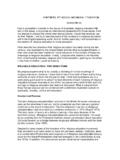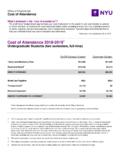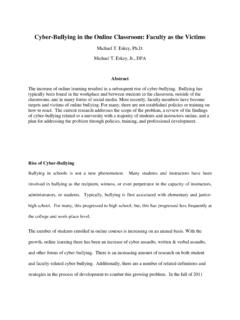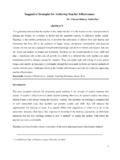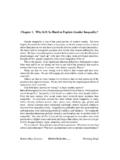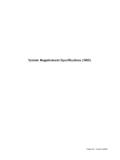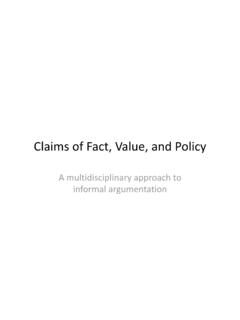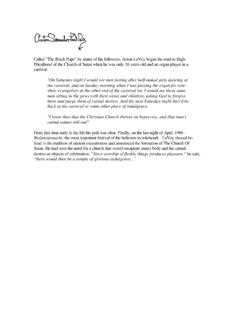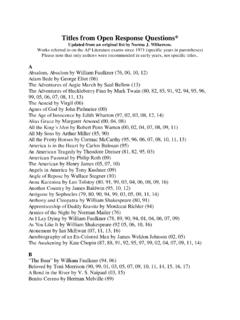Transcription of FROM FEMALE SEXUALITY AND HYSTERIA TO …
1 Tania Woods FROM FEMALE SEXUALITY AND HYSTERIA TO FEMININE. PSYCHOLOGY: THE GENDER OF INSANITY IN. LITERATURE. From the mad heroines of classic Victorian literature to the portrayal of insanity in modern Western texts and Middle Eastern writing, women suffering from mental instability have been a captivating subject. Using today's understanding of mental illness and psychological abnormality, do we find these women to be suffering from psychological conditions, or are they suffering from a FEMALE malady ? Is it simply the nature of their femininity that results in the representation of FEMALE madness in literature? The construct of women as deviant has a long history. It can be seen in the world's major religions and spiritual traditions, which often view women as uncontrollable . In particular the last two centuries has seen a greater interconnectedness between the concept of femininity and the cultural construction of madness. FEMALE sexual experiences play an important role in their development of psychological disorders.
2 Traditional psychological approaches often ignore the importance of these experiences. In literature we can see how the beliefs about FEMALE SEXUALITY have often been related to psychological symptoms once broadly labeled as HYSTERIA . The emergence of feminine psychology has progressed our understanding of the importance of gender in the diagnosis of conditions. By furthering our understanding of how women's SEXUALITY interplays with psychological conditions we may be able to better understand the links between SEXUALITY and psychological disorders, including how they have evolved historically from the Victorian era to the modern day. It is important to understand the value of FEMALE sexual expression and consider the impact that sexual repression and abuse can have in the development of certain psychological symptoms. In examining the representations of insanity in literary texts we can examine changing ideas about gender, social class and family structures, and the effect these factors have on what we consider to be sane.
3 History of Psychology Traditionally the study and application of psychology has been male dominated and feminists have criticized early psychoanalytic theory, particularly the work of Austrian neurologist Sigmund Freud, as being overtly sexist. His suggestion that women are mutilated men who must learn to live with the deformity of not having a penis, has been especially criticized. The term, coined by Freud, penis envy has persisted throughout popular psychology, and has been used as an off-hand rebuttal of feminist ideas. Some feminist thinkers have gone as far as to say that mainstream psychology has persistently misunderstood FEMALE experience in a systematic manner. (Gilligan, 1982). HYSTERIA HYSTERIA as a FEMALE condition has a history reaching back more than two thousand years. In it's colloquial usage HYSTERIA refers to emotional excess. hys-ter-i-a (noun). 1. Behavior exhibiting excessive or uncontrollable emotion, such as fear or panic. 2. A mental disorder characterized by emotional excitability and sometimes by amnesia or a physical deficit, such as paralysis, or a sensory deficit, without an organic cause.
4 (The American Heritage Dictionary of the English Language, 2009). The term is an abstract noun coming from the Greek hysterikos, which means of the womb . It was originally defined as a neurotic condition specific to women. The exact cause of HYSTERIA was not clearly defined, but it was thought to be the psychological manifestation of a disease of the womb. The idea of the wandering womb' had its beginnings in the teachings of Hippocrates. Ancient Greek medicine theorized that many FEMALE pathologies had their roots in a displaced womb. The idea, promoted by Hippocrates and later Plato, that women are more susceptible to irrationality and hysterical conditions, persisted into the Victorian era. Sigmund Freud's theories regarding HYSTERIA were directly influenced by these beliefs. Freud's study of Dora led him to theorize that hysterical symptoms stem either from psychological trauma or sexual problems. During psychotherapy Dora alleged that she had been the recipient of unwanted sexual advances from a family friend.
5 Freud dismissed these allegations, suggesting that she imagined the advances. He was however concerned that the imagined events were traumatic enough for Dora to develop HYSTERIA . Freud's case studies led him to develop his psychosexual stages of development theory. This controversial theory suggested that personality development occurred in stages and if any of these stages were not suitably completed it would result in psychological conditions, such as HYSTERIA , becoming manifested later in life. It incorporated his penis envy theory and the Oedipus complex theory, whereby a boy competes with his father for his mother's affections and views his father as a rival. Many of Freud's theories are discredited today, but their ongoing influence can still be seen. HYSTERIA may no longer be a recognized condition today, but it symptoms can be seen in conditions like anxiety, depression and obsessive compulsive disorders. Feminine Psychology The study of psychology has historically been approached from the male perspective.
6 A new branch of feminine psychology grew out of the women's movement of the 1960's. These new theories counteracted the predominant thinking, research and practices that had become outdated in light of the feminist revolution. Feminist psychology takes in to account both sex as a biological difference and gender, as a set of socially determined norms and values. A key component of FEMALE centered psychology is that problems are viewed in a sociopolitical and cultural context. Women's experiences are taken into account, and definitions of mental illness are adjusted to reflect distress that could, as a result of these contexts, be seen as normal. The work of early psychoanalysts ignored the life events and experiences of women, preferring to cover many conditions with the blanket term neurosis. Psychologist Karen Horney considered neurosis to be a common condition in both males and females, but believed that it is only when we are overwhelmed by external conditions that the condition surfaces.
7 Horney sought to assert that womb envy , in which males are envious of women's ability to create life was a counter theory to penis envy . These theories, while extreme, help to explain the struggle of women during the 19th century to gain a distinct psychological identity. (Horney, 1991). In her influential feminist text The Dialectic of Sex: The Case for Feminist Revolution, Shulamith Firestone suggests that Freud's Penis Envy theory was not completely redundant, if every time he used the term penis, it was replaced with the term power. Feminine psychology takes into account the cultural influences of women's experiences and their historical position in society as the weaker sex. It also focuses on the balance required by women to partake in traditional roles such as motherhood together with modern roles, such as being economically independent or as career women. Women as victims of abuse When looking at psychological conditions that are predominantly suffered by women, it is important to take into account the sexual experiences of women.
8 Eating disorders, depression and anxiety are all gender biased conditions. The prevalence of these psychological issues in women is possibly, at least in part, a consequence of domestic violence and sexual abuse. Healthcare providers when providing counseling and psychotherapy. should address these connections. Throughout their many life stages, women are at a greater risk of violence and sexual abuse. According to the World Health Organization, the prevalence of violence against women in their lifetime is 16% to 50% and at least one in five women suffer rape or attempted rape. Depression, anxiety, psychological distress, sexual violence, domestic violence and escalating rates of substance use affect women to a greater extent than men across different countries and different settings. Pressures created by their multiple roles, gender discrimination and associated factors of poverty, hunger, malnutrition, overwork, domestic violence and sexual abuse, combine to account for women's poor mental health.
9 There is a positive relationship between the frequency and severity of such social factors and the frequency and severity of mental health problems in women. Severe life events that cause a sense of loss, inferiority, humiliation or entrapment can predict depression. (World Health Organization, 2012). FEMALE madness in Victorian literature I will hold to the principles received by me when I was sane, and not mad as I am now. Laws and principles are not for the times when there is no temptation.. They have a worth so I. have always believed; and if I cannot believe it now, it is because I am insane quite insane: with my veins running fire, and my heart beating faster than I can count its throbs. (Bront , Jane Eyre, 1847). In literature we can see the link between sexual abuse and psychological distress clearly expressed. Sexual repression is often seen as the embodiment of the Victorian Era. 19th century literature helps us to understand the experiences of women in this period and the censorship faced by those trying to explore such issues.
10 Women were given one goal, marriage. Most women were unable to support themselves economically and those who were, but chose to remain unmarried were often ridiculed, labeled as old maids and spinsters'. Being a wife, a mother and a lady were viewed as the pinnacle of success for a FEMALE . Moral purity and virginity were valued highly in a prospective wife. This moral capital was used as currency when arranging partnerships, especially in the middle classes. The upper classes could afford to be more morally careless whilst the working class, who had very little chance of significantly raising their family's status, did not need to adhere to such stringent moral rules. Middle class females however, had considerable pressure placed upon them. A successful marriage could advance their family's social standing whilst failure' could result in destruction of the family's reputation and economic downfall. Victorian FEMALE authors also subscribed to traditional images of insanity.
